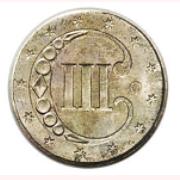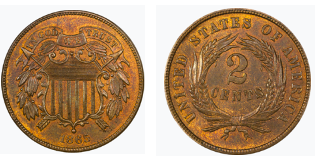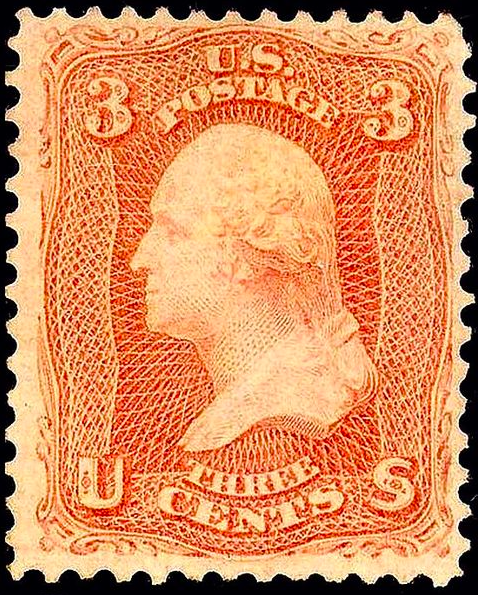
Coins are fascinating; they provide a special insight into American history. In fact, one could argue that they make you part of history in a small way. If you grew up in the 1960s – before The US Mint stopped using silver (1) in its "silver coins" – and could routinely look through your change and find Buffalo Nickels, Standing Liberty Quarters, and Indian Head Pennies, some of which were minted in the 19th century. You would know with certainty that the particular coin in your hand was once in the pocket of someone who fought in the Civil War, perhaps even before. Although those coins are long gone from circulation, they leave behind small round bits and pieces of American History.
For example, did you know there was an enormous demand for nickel during World War II, especially for hardened armor plating for tanks and planes? Although the mint could have temporarily stopped making the coin, instead, it made them out of silver and copper (no nickel) for the first and only time (1942-45). Because copper was also a valuable commodity during the war (circuitry and motors), in 1943 (only), pennies were made from steel with a zinc coating. (If you haven't seen one, they are really strange-looking.)

(Left) 1943 steel penny. (Right) 1943 Silver War Nickel
A Numismatic History Lesson, Which May or May Not Be Useful or Even Interesting
Did you know that the first real person on an American coin was Abraham Lincoln, who debuted on the penny in 1909 and still does today? The second person was George Washington (1932 Quarter), followed by Thomas Jefferson (1938 Nickel) and FDR (1945 Dime). The first actual woman to be depicted on a coin was Susan B. Anthony (one-dollar coin in 1979), but Americans hated this coin. Nothing against Ms. Anthony, but the chuckleheads who designed it couldn't have made it look more like a quarter if they stamped "This ####ing thing Is Worth 25 Cents" on it, resulting in constant confusion. As you can see below, the Anthony Dollar was almost the same size and made out of the same metal. Take a look:

(Left) Susan B. Anthony Dollar Coin next to Washington Quarter. Duh. (Right) The Sacagawea Golden Dollar Coin.
The Anthony Dollar bombed, but in an attempt to gain American acceptance of a dollar coin, the Mint introduced the Sacagawea Golden Dollar Coin in 2000. Still no good. It turns out that Americans love dollar bills and hate dollar coins. In 2000 one billion golden dollar coins were minted. By 2008, the last year they were produced, that number had dropped to less than four million.
Strange Denominations
Early in our history, when pennies actually had some value (2), they were huge, heavy, and made of pure copper. To show that whining didn't begin in the 21st century, people complained about these, too, although they may have had a point: A penny in the early-mid 18th-century weighed almost 2.5-times more than today's quarter. Perhaps the Mint foresaw this concern, so it decided to begin minting the half-cent and large cent in 1793 – the first year that US coins were minted (3). The half-cent wasn't especially popular either.

The Government Responds! But Not Quickly
The large-cent bitching era lasted for quite a while. Sixty-four years to be exact. In 1857 both the large-cent and half-cent went to the big tip jar in the sky. The half-cent was never minted again, while the large-cent emerged in 1859 as the Indian Head Penny, which is the same size as modern pennies.
The Two-Cent Piece
Since the half-cent and large-cent coins weren't crowd-pleasers, the Mint tried out a two-cent piece in 1864. I think it's a cool-looking coin, and the American public must have too; it was enthusiastically received, but it didn't even last a decade. Bigger denominations were needed...

An 1865 Two-Cent Piece
...Because This Happened
Putting aside everything you think you know about life, postage rates went down in 1851 from five cents to three cents for a standard letter. The smallest denomination stamp was five cents, so the Postmaster General came up with a 3 cent George Washington stamp. The Mint reacted.

1851 George Washington 3-cent stamp. VERY valuable.
A Beautiful, Tiny Mistake – The Silver Three Cent Piece

An 1851 Silver Three-Cent Piece. The smallest coin ever minted in the US. You won't find one in your change (even if it's in there.)
When the three-cent stamp was issued, people were still lugging around gigantic large cents and half cents. A coin that was "easy to handle" was needed, and the Mint responded by producing the silver three-cent piece (nicknamed "trime") – the smallest US coin ever made and possibly the most foreign-looking. Try handing this to someone at Walgreen's and see what happens. These bad boys are really small. And also really thin.
To put this in perspective, in 1851, the large-cent had not yet been replaced by the (small) Indian Head Penny, bringing up the rather strange situation where the penny weighed more than 15-times more than the 3-cent piece and was more than double its diameter.

An 1861 "trime" (left, 14 mm, 0.6 mm thick) is dwarfed by the modern penny. By contrast, a large cent is the Death Star. Photo credit: Coin Talk. These images represent the actual size of each coin.
Too Easy to Handle and Not So Sturdy
The Mint got its wish. The 3-cent piece was quite easy to handle and even easier to lose. While it was enthusiastically received at first, the flaws in the delicate beauty became apparent. Before long, it was being called unflattering names. Imagine insulting a coin!
These were known as "fish scales" because they were easily lost and became discolored and dirty.
The Philadelphia Mint struck 5,446,400 pieces in 1851. At the same time officials struck an additional 720,000 in New Orleans. Public reception was not favorable; many believed the coins were too small and easily lost.
But they also failed because they were too popular.
The Gold Rush, Metal Inversion, and the End of the Trime
In 1848 gold was discovered in Sutter's Mill, California. Soon thereafter, the Gold Rush was in full swing. As prospectors flooded in from all over the country, California exported so much gold that its price dropped – so much that at one point, silver became more valuable than gold. This was another reason that the trime was first minted. Silver coins were being hoarded because of the intrinsic value of the metal, but the first trime consisted of 75% silver and 25% copper, making it not quite worth hoarding (4).
This all changed with the beginning of the Civil War. By the end of 1861, East coast banks stopped changing paper money into coinage (5), and the hoarding of copper and silver coins went wild. Although the 3-cent piece was minted until 1871, most were hoarded and shipped overseas or melted down for the metal value.
Science Alert!
Silver coins contain varying amounts of copper, usually 10%. How can you get rid of the copper? It's actually easy because of the difference in melting points between the two metals (silver - 961°C, copper -1084°C). Basically, you take the coins and put them in a crucible and heat the #### out of it until the silver starts to melt. Then you pour out the liquid silver, leaving the copper schmutz behind. Don't try this at home.
I hope you enjoy this article which is a little bit of a change (pun alert) from what I usually write. Although many numismatists may disagree with my assessment of the "trime," I'm just throwing in my "three cents worth" – a term I just coined.
NOTES:
(1) Starting in 1965 The Mint stopped using silver in dollars, half-dollars, quarters, and times. Had I had the brains to hoard everything minted in 1964 or earlier I would not be toiling away at this miserable job. Single pre-1965 dimes are selling for about $2.00 on eBay.
(2) Pennies are stupid and harmful to the environment, something I've written about.
(3) There is an ongoing debate about whether these 1793 coins were the first US coins minted. Some claim that the 1792 half-dime was the first. I'll stay out of this one. Too political.
(4) After a few years the composition was changed to 90% silver and 10% copper. It's complicated. Let's just say that hoarding became a problem.
(5) At this time, paper money was made by individual states. When the Civil War broke out it became worthless. The first US paper money was an 1862 one-dollar bill.



